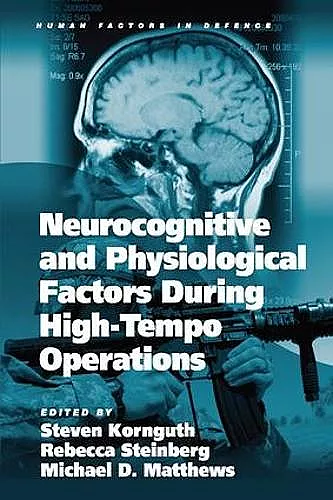Neurocognitive and Physiological Factors During High-Tempo Operations
Rebecca Steinberg author Steven Kornguth editor Rebecca Steinberg editor
Format:Paperback
Publisher:Taylor & Francis Ltd
Published:31st Mar '17
Currently unavailable, and unfortunately no date known when it will be back
This paperback is available in another edition too:
- Hardback£160.00(9780754679233)

Neurocognitive and Physiological Factors During High-Tempo Operations features world-renowned scientists conducting groundbreaking research into the basic mechanisms of stress effects on the human body and psyche, as well as introducing novel pharmaceutics and equipment that can rescue or improve maximal performance during stress. Its focus is on the military model as an exemplar for high-stress environments, the best for understanding human performance under stress, both in the short-term as well as in the long-term. The unprecedented demands on the modern soldier include constantly shifting enemy threat levels and tactics, ambiguous loyalties, rapidly evolving weaponry, and the need to amass, comprehend, retain, and act upon large datasets of information. During high-tempo operations, soldiers must maintain superior cognitive and physical skill levels throughout extended periods of little to no sleep. Furthermore, although a soldier fresh from training may perform at peak skill, the effects of cognitive and physical strain and sleeplessness during deployment can impair his or her ability to transfer instructional knowledge to complex real-life situations. It is necessary to understand how intense workloads, both mental and physical, combine with total sleep deprivation to alter soldier situation awareness, decision-making, and physical abilities. The resulting knowledge can be used to design rapid, deployable fitness-for-duty measures, alter training protocols, and assess training efficacy in order to enable decision-makers to act at peak ability during high operations tempo. In addition, dual-use applications of resulting knowledge and technology extend well into the civilian sector, to law-enforcement officers, healthcare professionals, and emergency responders. The book differs from many previous human factors publications by presenting state-of-the-art neuroscience data in a format that is comprehensible and informative for readers of diverse backgrounds. It not only details human behaviors and perception, but also provides concise brain imagery and physiological findings to support its conclusions. In addition, the incorporation of the US Army soldier model of extreme stress and extreme performance demands provides a real-life theme that anchors the scientific, organizational, assessment and response aspects of each chapter. This book synthesizes hard facts with real-life accounts of performing under stress and shows how a large oversight institution like the US Army can measure and improve human factors considerations for its members.
'This well-written report is for the serious student interested in soldier performance. It describes today’s unique challenges faced by the military as well as factors common to all conflicts. Research using advance neuroscience tools is presented along with implications for selection, training and insuring optimal performance. It is a superb compilation of today’s neuroscience and tomorrow’s solutions.' Ronald R. Blanck, Former US Army Surgeon General and Commander, US Army Medical Command 'This book brings the fruits of four decades of basic neuroscience research on how the brain adapts to stress into the real world of military operations. The evidence collected here makes clear that methods are now at hand to determine who is vulnerable to such stresses and what pharmacology may some day be able to do for them. A "must read" for strategists.' Floyd E. Bloom, The Scripps Research Institute, USA 'Kornguth, Steinberg and Matthews have assembled a stellar group of cutting-edge scientists who address a spectrum of crucial neuro-cognitive and physiological issues involved in human performance in extreme conditions. Ranging from the very forefront of theoretical neuroscience to the practical experiences of current military veterans, this work provides critical insights for all who seek to understand the multiple dimensions of human capacities when faced with exceptionally demanding and emergency situations. Not only for the professional researcher or field commander, this text can serve to inform and direct the understanding of students, administrators, representatives and the wider public on our current state of scientific understanding in this vital area of human response capacity.' Peter A. Hancock, University of Central Florida, USA
ISBN: 9781138072725
Dimensions: unknown
Weight: 453g
286 pages